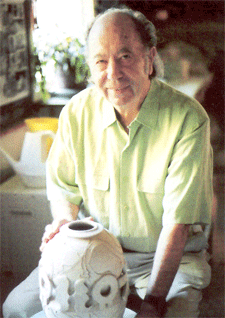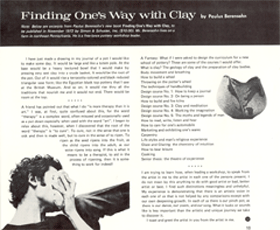Gerry Williams: Living Treasure

|
|
Gerry Williams in his studio in Dunbarton, N.H. |
“It is still an enigma to me how and why I enjoy potting,” says Gerry Williams of his 50-odd years as a leading ceramic artist. “I feel about pottery what William Stafford said about poetry: 'I don't want to make good poems, I want to make inevitable poems.' Pottery is what I do, who I am, where I come from.”
Williams hails from India, where he was born in 1926 and grew up with his American family in the last years of the British Raj. “My parents were missionaries, running a missionary school in Bengal. One thing my father did was to change the form of sanitation. He made a type of septic tank. Gandhi heard about it and when he came to see it he asked my father to build one in his house, which my father did. He went to Gandhi's ashram several times and built and installed his septic system.
“Gandhi went to jail soon after this. [Years later] I visited the World Agricultural Fair in New Delhi and went to see the replica of Gandhi's house there. There was a plaque there: 'Toilet installed by F. G. Williams.' I told my father, and he was very pleased about that.
“I never met Gandhi myself because we were in school when he came. But I have been deeply influenced by Gandhi over the years. The idea of handicraft and low agricultural economies, living in mud-brick homes, growing things, making things for use by other people.
“[Gandhi] also influenced me in my ethics and moral life. I became a pacifist and spent time in jail as a conscientious objector. He allowed me to say 'what am I going to do with my life that will be ethical and politically responsible?' Being a potter is what I came to believe the answer to that question was.”
Return to America
Early in World War II, Williams returned to the United States to study at Cornell College in Iowa. “I was only there for a year before I was called up for service in the military. Fighting in a war did not fit with my morals, so I became a C.O [conscientious objector].” He left college for several years in alternative war service. Fifty-five years after his early departure, Williams' alma mater finally awarded him a degree: Doctor of Fine Arts (honorary).
Pottery came into Williams' life several years later. In the late 1940s, he was living in a cabin he had built on Vinal Haven Island, off the coast of Maine. “Then I was 'post-everything'---post-college, post-everything else. I intently wanted to do something meaningful,” Williams remembers. “I read a passage by Arthur Morgan [former president of Antioch College and chair of the Tennessee Valley Authority under President Franklin Roosevelt] about the meaning of making pots. That was the answer.”
Pilgrim to New Hampshire
Through a friend in Boston, Williams heard that, thanks to the League of New Hampshire Craftsmen, New Hampshire was one of the best places in the country to study pottery and ceramics. In 1949, he moved to Concord, then as now the League's headquarters.
“David Campbell, director of the League of New Hampshire Craftsman [from 1938-1962], an architect, helped me get started,” Williams says. “A lot of people came to New Hampshire because of the need to be in a movement, where there were people, where there was a market because of the League.
“There were also wealthy women who supported craft. They had second homes in New Hampshire, places they went to in the summer. They were interested in the social movement of the art rather than specific enterprises.”
Williams soon prospered, becoming one of the few potters in America to support himself through his creative work. In 1953, he built a home and studio not far from Concord in rural Dunbarton.
“I had married. My wife was a radio personality in New Hampshire who had interviewed me once on her station. She and I bought this property and built the house, not with a lot of money but with help. In those days, the crafts community spent weekends going from place to place helping put on shingles and the like. Then we helped others. No money at all, just the well-being of the community being served.”
From Potter to Publisher

|
|
A spread in the first issue of The Studio Potter, 1972. |
Another important milestone in Williams career came in 1972, the year he founded The Studio Potter magazine, which he edited for more than 30 years. Under his stewardship, it became one of the most influential art publications in the United States.
“Before I started The Studio Potter, there were two publications for ceramics, one for galleries and shops [Craft Horizons] and one for academics [Ceramics Monthly]. I felt the working craftsmen were getting shorted. I wanted to write for people working in the studio.
“Without any prior experience in publishing, I started the magazine as a nonprofit entity. During the years I was editor I attempted to travel everywhere in the country to interview people—-active studio people rather than designers or gallery owners exclusively or in the college environment.
“To a large extent anyone who made pots we were interested in. There were enormous amounts of people out there. Everyone had a special story to tell. I especially like to find someone who had given up something to become a potter.
“We would go to a state, find someone to set up an itinerary. Then my wife and I would go around interviewing people. It was amazing how many there were even in the most isolated areas. We still have friends we met out on the trails somewhere.
"It's been a wonderful life.”
Gerry Williams will give a gallery talk about The Studio Potter Collection on Thursday, Sept. 14, at 7:30 p.m., in the Mugar Gallery.


